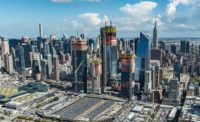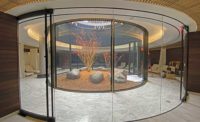At its projected completion in late 2013, the tower will be New York’s fourth-tallest building at 1,080 ft. Its rooftop antennae add about 100 ft to its height.
As with Two World Trade Center, the Port Authority considered downscaling the third tower to a retail stump in 2009, before the influx of public cash ended the dispute with Silverstein.
Sean Johnson, Silverstein’s vice president in charge of the tower’s construction, says one way the parties resolved their dispute was by agreeing to build the concrete core first to save time and money. It was a bold move. Until recent years, the concrete-first method was avoided in New York because of safety concerns raised by trades who would have to work below other trades. Eleven Times Square, completed in 2010, was the first time a slip-form concrete core was erected before the steel frame on a New York City tower.
As an additional safety measure at the World Trade Center, construction manager Tishman Construction is installing wrapped scaffolding around the core that gets jacked up as the building rises, to prevent debris from falling out from the core.
Referred to as the “blue cocoon” because of the blue netting that covers the scaffolding, Tishman created the system in 2009 after a hammer plummeted 18 stories and smashed through the rear of a taxi outside its Goldman Sachs tower project site.
“That’s something that we developed for these buildings because of the height and the wind down in this neighborhood,” says Mike Mennella, executive vice president of World Trade Center Projects at Tishman. “We learned a lot over at Goldman Sachs.”
Johnson is confident that Three World Trade Center will continue on schedule and reach ground level by the end of the year. Foundations are nearing completion, he adds. “We are going to mobilize our superstructure concrete contractor first week of March, and we’re going to start going vertical,” Johnson says.
Tower Four
Of the three projects, Four World Trade Center—now at more than 10 stories high—is the only building pedestrians can currently see from street level. At its projected completion in 2013, the Fumihiko Maki-designed building will rise 64 stories (975 ft).
Article toolbar


Post a comment to this article
Report Abusive Comment